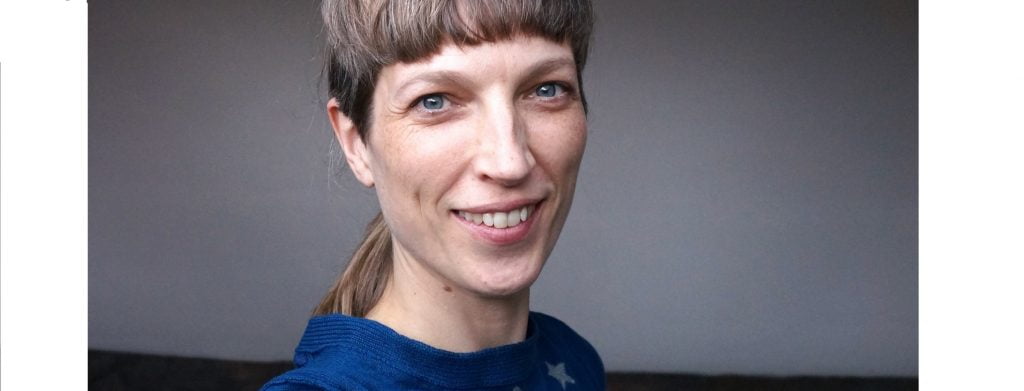
- News
Interview: Kate McIntosh about In Many Hands
Kate McIntosh is a Brussels-based artist from New Zealand who actively involves her audiences in her shows. During In Many Hands, McIntosh invites the SPRING audience to feel, smell and experience – a multi-sensory situation which is almost like a ritual.
Kate McIntosh is a Brussels-based artist from New Zealand who actively involves her audiences in her shows. Her works often focus on the physicality of both performer and audience, the manipulation of objects and materials, and the development of direct relations with and between audience members. Kate’s practice is guided by her ongoing fascinations with the misuse of objects, playfulness with the public, a love of theatrical images and an off-beat humour.
What was your motivation to work in performing arts?
“I started out as a dancer, and worked for many years in dance theatre at different companies around the world. I ended up in Brussels, and started making my own work. I immediately moved away from choreographic work into language and what I would really call performance, which is the mix of quite a few different disciplines. Since I started making my work I’ve always tried to do things I don’t know how to do. So that’s how I immediately launched working with text and later working with music and installations, and many other different forms. When I make a new project I’m exploring some form that I haven’t tried before or don’t know how to do yet. So that is pushing me forward, to try new things all the time.”
During In Many Hands, McIntosh invites the SPRING audience to feel, smell and experience – a multi-sensory situation which is almost like a ritual. It is both a sensory experience and a subtle social experiment to trigger an unspoken dialogue between strangers.
What was the starting point to create In Many Hands?
“In Many Hands is the third in a trilogy of works. The first one was Worktable, which was a live installation, then there was a piece called All Ears which was a stage performance, and now there’s In Many Hands. All of them involved the audience in different ways. During Worktable people go into the installation alone, and have to choose an object to take apart. So it is very physical and practical, but not very social because you’re always alone whilst you do it. The stage piece All Ears involves the audience, it is very social and a lot about people looking around at each other. I’m on stage, directing people to keep their attention. The audience acts like a sort of orchestra, they make the soundtrack for the work. In Many Hands is the end of this exploration, and it’s a piece without words. It’s only about the sensory exploration. It’s quite social, but very quiet and sensitive as well.”
Why do you prefer to work with the audience?
“One of the reasons I launched this trajectory – which is very different to what I was doing before, I was really a stage animal – is because I don’t really like participation myself, as an audience. I’m very slow to participate when I’m invited, I’m very cautious and often don’t like the circumstances in which participation is proposed. I became interested in that, why do some people become enthused easily and don’t have a threshold, while others like me are much more cautious. It made me think a lot about the social and political dynamics that are wrapped up in that move towards participation. The challenge I set myself was to make a performance that even I would trust enough and would be interested enough to get involved in and to explore and find out what it is about.”
What can people expect when joining the performance?
“People work with their hands as the title suggests, with materials and objects. It’s very much about heightening their own sense of touch and sight and sound, about the body skills that we have to receive the world. I was working with dance before, and I was interested in the bodies of the performers. Now my interest has switched to the bodies of the audience, how they experience the work physically and what that means to different people.”
What is your favorite object that goes through the room during the performance?
“I´m very familiar with these objects now of course! I´ve done the piece many times. Luckily there is something surprising every time. It´s like a small museum, there are some objects that are very special and unusual. It doesn’t happen often, but occasionally someone doesn’t want to touch a particular thing at all. But there are also some objects that are familiar to everybody, and I like that they go together. When the performance works well, somehow everything is quite surprising. Even the mundane things, the things you think are familiar they take on a new character, mainly because you allow yourself to become sensitized. What I love most is to see how other people contact these objects.”
Where do you get your inspiration from?
Mainly my colleagues, and the many other artists whose work I go and see. I find it really nourishing to know that my work is in conversation with a lot of other different artworks people are making. For me it´s most important to stay in a conversation with audiences and other artists. The natural world is also really important to me, coming from New Zealand. I love to spend time in the wild, that´s a big energy-giver.
Can you give us a sneak peak in your future plans?
I´m very interested in sound and voice, this something I’ve been doing workshops and research around, so maybe that will lead to the next thing!
• In Many Hands can be seen on 18-20 May at Stadsschouwburg Utrecht. Click here for tickets!